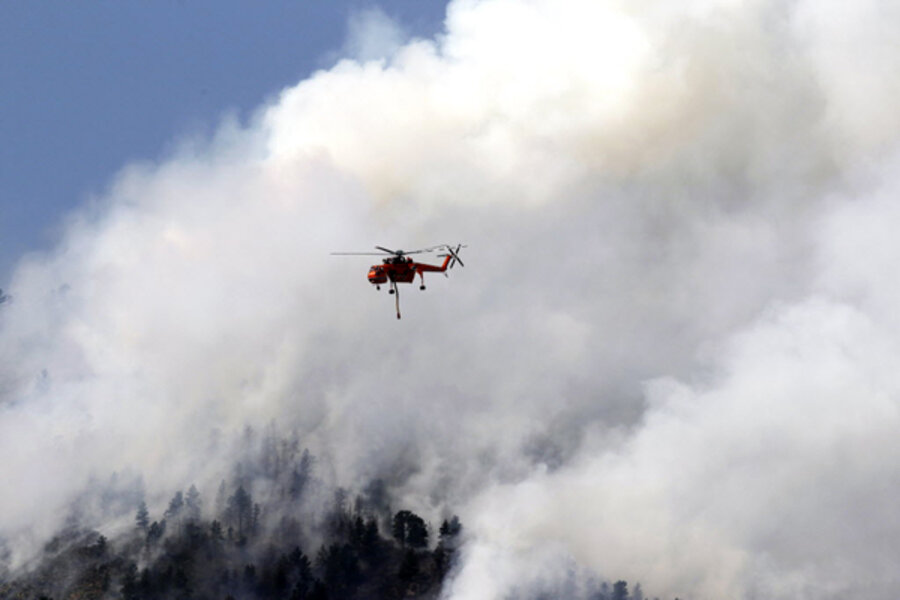Wildfires burn out of control in New Mexico and Colorado
Loading...
| BELLVUE, Colo.
Firefighters battling an out-of-control Colorado blaze significantly increased the number of structures destroyed or damaged to at least 118 on Monday as crews in New Mexico also ramped up efforts against a large out-of-control blaze.
Colorado officials increased the damage estimate by 100 structures after crews got a better estimate of blackened areas where subdivisions once stood. Firefighters said they couldn't immediately say how many of the damaged structures were homes and how many were sheds, barns or other buildings.
The fire was first reported Saturday and comes as authorities say they're competing for resources that have been diluted by several wildfires across the West. The U.S. Forest Service added four tankers, including two from Canada, to its firefighting fleet last week following the crash of a tanker that killed two pilots at a southern Utah wildfire.
Ten air tankers and 400 firefighters were at the northern Colorado fire burning nearly 60 square miles in a mountainous area about 15 miles west of Fort Collins.
"Resources are thin right now," said Nick Christensen of the Larimer County Sheriff's Office. "We are trying to get more of everything at this point."
The wildfire west of Fort Collins has nearly doubled to 58 square miles, forcing hundreds of evacuations.
One person remains missing in the Colorado fire, which has spread smoke as far as central Nebraska, western Kansas and Texas.
In New Mexico, fire managers hoped to use a break in the weather to fight a 54-square-mile blaze near Ruidoso from the air. Winds grounded aircraft there Sunday. Residents in Ruidoso were told to prepare to evacuate if conditions worsen.
Hundreds of people have evacuated their homes and dozens of buildings have been destroyed as the fires spread rapidly, authorities said.
New Mexico Gov. Susana Martinez announced late Sunday that she was ordering an additional 100 National Guard troops to assist with evacuations. They will be dispatched to shelters or highways where people have to be turned back, Ruidoso spokeswoman Kerry Gladden said.
Military helicopters were also deployed to drop water at both fires in addition to air tankers dropping slurry.
Dan Ware, a spokesman for the New Mexico State Forestry Division, said the number of Ruidoso evacuees was in the hundreds, but he didn't have an exact figure. The nearby community of Capitan and others also could face evacuation, said Karen Takai, a spokeswoman for the Ruidoso fire crews.
"Any communities around this fire have the potential of being evacuated," she said. "If I lived in Capitan, I definitely would be prepared. Don't wait until the sheriff's office comes knocking at your door and tells you to evacuate."
Both fires were dwarfed by a massive blaze in southwest New Mexico — the largest in the state's history — that has charred 435 square miles of wilderness forest since mid-May. But the smaller blazes were especially concerning because they were closer to more populated areas.
Elsewhere Monday, firefighters battled a wildfire that blackened 6 square miles in Wyoming's Guernsey State Park and forced the evacuation of hundreds of campers and visitors. Authorities are warning the 70 people who live in Hartville to be ready to leave in an hour's notice.
Evacuation notices were sent in Colorado to nearly 1,800 phone numbers, but it wasn't clear how many residents had to leave. Larimer County Sheriff Justin Smith said there was an unconfirmed report of a person unaccounted for, but he wouldn't elaborate.
Authorities said it was the worst fire in Larimer County in about 25 years.
Elaine Mantle and her family got a call to evacuate their Bellvue home early Sunday, their first evacuation in the 25 years that they have lived in the mountains. It took about 30 minutes for them to get out and reach a spillover shelter in Loveland.
"We're all here, we're all OK. Our neighbors are all here. We feel good," Mantle said.
Kathie Walter and her husband helped friends several miles away evacuate from the Colorado fire on Saturday. When they got home, they were surprised to get a call warning them to be ready to evacuate.
Walter didn't want to wait.
"Smoke was coming in hard. We could not see flames or orange or black smoke. But we didn't need to see anymore. We just said 'Hey, let's get out of here,'" she said.
They left with their five cats and two dogs, getting a head start. After a wildfire in the area last year, they left two suitcases packed in their garage.
The fire is the latest to hit Colorado's drought-stricken Front Range. In May, a fire set by a camper's stove charred 12 square miles in the same Poudre Canyon area. In March, a fire sparked by a prescribed burn 25 miles southwest of Denver killed three people and damaged or destroyed more than two dozen homes.







